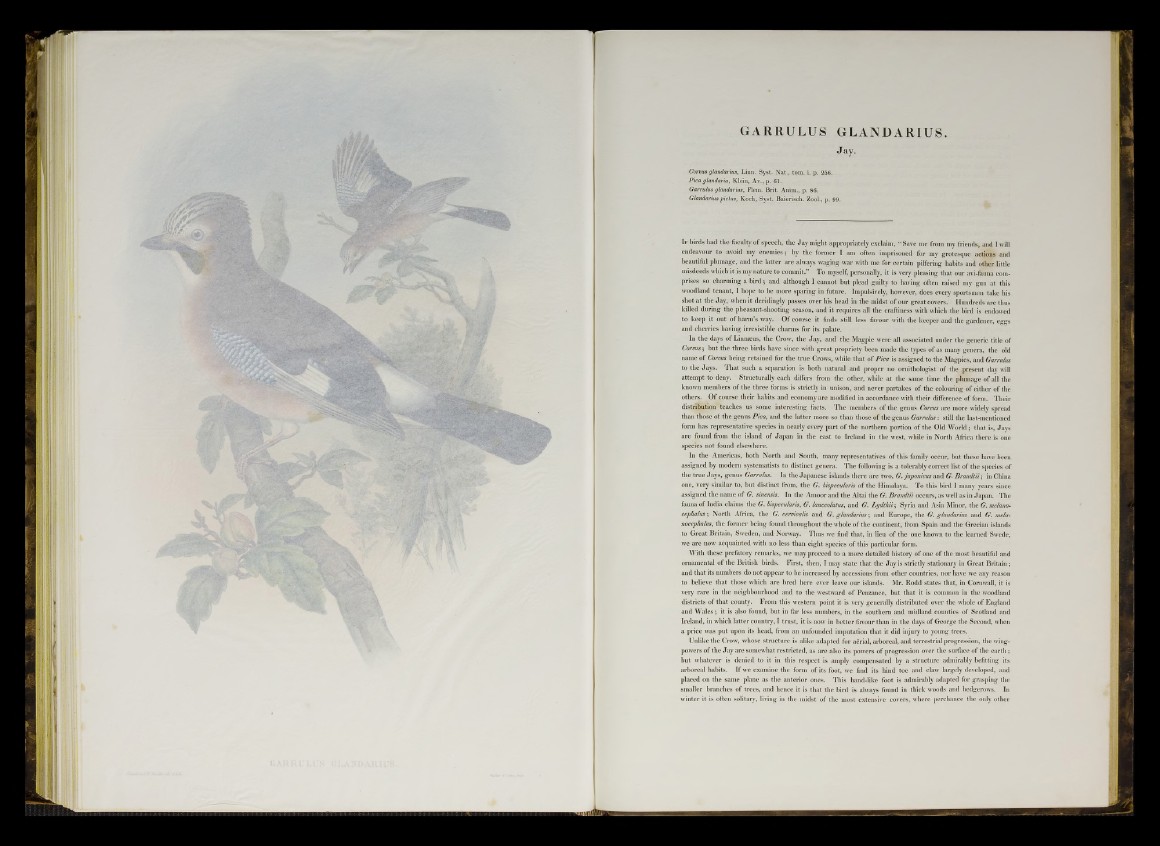
GARRULUS GLANDARIUS.
Jay.
Corvus glandarius, Linn. Syst. Nat., tom. i. p. 256.
Pica glandaria, Klein, Av., p. 61.
Garrulus glandarius, Flem. Brit. Anim., p. 86.
Glandarius pictus, Koch, Syst. Baierisch. Zool., p. 99.
I f birds had the faculty of speech, the Jay might appropriately exclaim, “ Save me from my friends, and I will
endeavour to avoid my enemies; by the former I am often imprisoned for my grotesque actions and
beautiful plumage, and the latter are always waging war with me for certain pilfering habits and other little
misdeeds which it is my nature to commit.” To myself, personally, it is very pleasing that our avi-fauna comprises
so charming a bird; and although I cannot but plead guilty to having often raised my gun at this
woodland tenant, I hope to be more sparing in future. Impulsively, however, does every sportsman take his
shot at the Jay, when it deridingly passes over his head in the midst of our great covers. Hundreds are thus
killed during the pheasant-shooting season, and it requires all the craftiness with which the bird is endowed
to keep it out of harm’s way. Of course it finds still less favour with the keeper and the gardener, eggs
and cherries having irresistible charms for its palate.
In the days of Linnseus, the Crow, the Jay, and the Magpie were all associated under the generic title of
Corvus; but the three birds have since with great propriety been made the types of as many genera, the old
name of Corvus being retained for the true Crows, while that of Pica is assigned to the Magpies, and Garrulus
to the Jays. That such a separation is both natural and proper no ornithologist of the present day will
attempt to deny. Structurally each differs from the other, while at the same time the plumage of all the
known members of tlie three forms is strictly in unison, and never partakes of the colouring of either of the
others. ^ Of course their habits and economy are modified in accordance with their difference of form. Their
distribution teaches us some interesting facts. The members of the genus Corvus are more widely spread
than those of the genus Pica, and the latter more so than those of the genus Garrulus: still the last-mentioned
form has representative species in nearly every part of the northern portion of the Old World; that is, Jays
are found from the island of Japan in the east to Ireland in the west, while in North Africa there is one
species not found elsewhere.
In the Americas, both North and South, many representatives of this family occur, but these have been
assigned by modern systematists to distinct genera. The following is a tolerably correct list of the species of
the true Jays, genus Garrulus. In the Japanese islands there are two, G. japonicus and G- Brandtii; in China
one, very similar to, but distinct from, the G. bispecularis of the Himalaya. To this bird 1 many years since
assigned the name of G. sinensis. In the Amoor and the Altai the G. Brandtii occurs, as well as in Japan. The
fauna of India claims the G. bispecularis, G. lanceolatus, and G. Lydthii; Syria and Asia Minor, the G. melano-
cephalus; North Africa, the G. cervicalis and G. glandarius; and Europe, the G. glandarius and G. mela-
nocephalus, the former being found throughout the whole of the continent, from Spain and the Grecian islands
to Great Britain, Sweden, and Norway. Thus we find that, in lieu of the one known to the learned Swede,
we are now acquainted with no less than eight species of this particular form.
With these prefatory remarks, we may proceed to a more detailed history of one of the most beautiful and
ornamental of the British birds. First, then, I may state that the Jay is strictly stationary in Great Britain;
and that its numbers do not appear to be increased by accessions from other countries, nor have we any reason
to believe that those which are bred here ever leave our islands. Mr. Rodd states that, in Cornwall, it is
very rare in the neighbourhood and to the westward of Penzance, but that it is common in the woodland
districts of that county. From this western point it is very generally distributed over the whole of England
and Wales; it is also found, but in far less numbers, in tbe southern and midland counties of Scotland and
Ireland, in which latter country, I trust, it is now in better favour than in the days of George the Second, wheu
a price was put upon its head, from an unfounded imputation that it did injury to young trees.
Unlike the Crow, whose structure is alike adapted for aerial, arboreal, and terrestrial progression, the wing-
powers of the Jay are somewhat restricted, as are also its powers of progression over the surface of the earth;
but whatever is denied, to it in this respect is amply compensated by a structure admirably befitting its
arboreal habits. If we examine the form of its foot, we find its hind toe and claw largely developed, and
placed on the same plane as the anterior ones. This hand-like foot is admirably adapted for grasping the
smaller branches of trees, and hence it is that tbe bird is always found in thick woods and hedgerows. In
winter it is often solitary, living in the midst of the most extensive covers, where perchance the only other